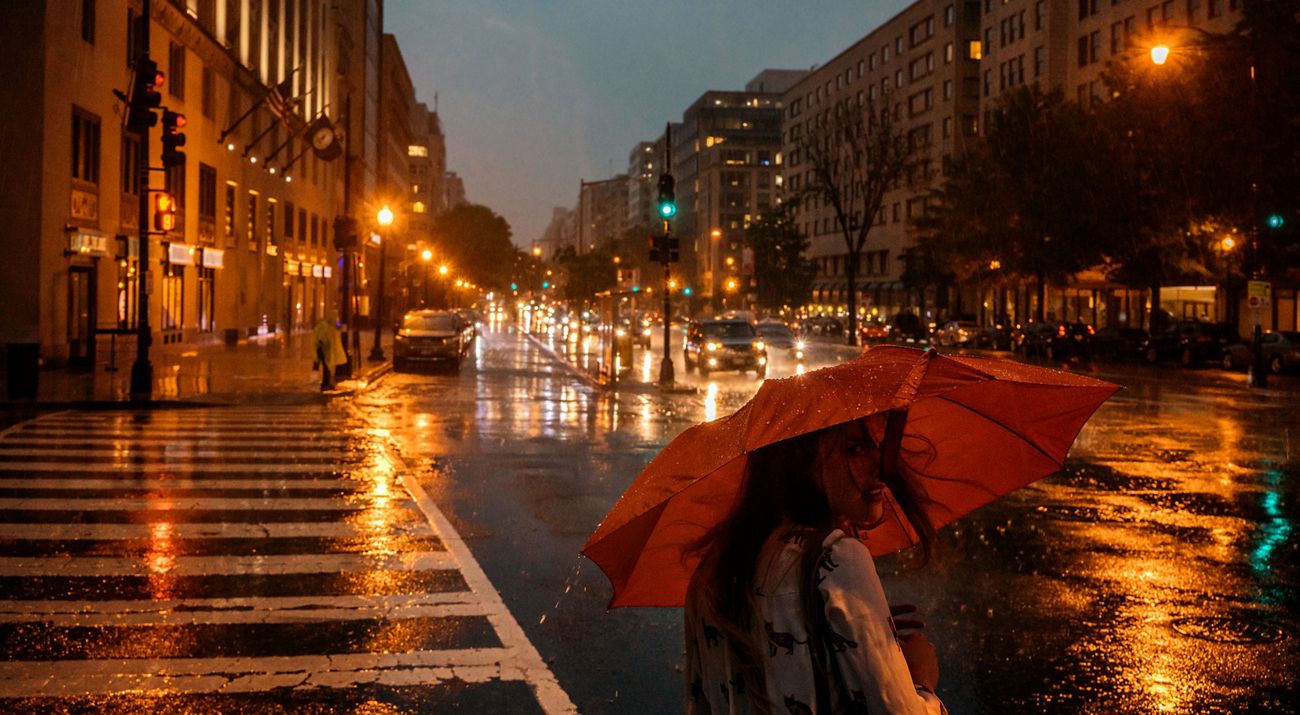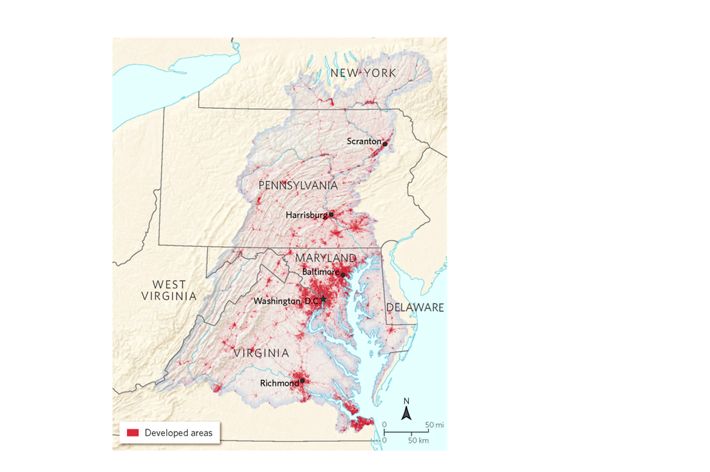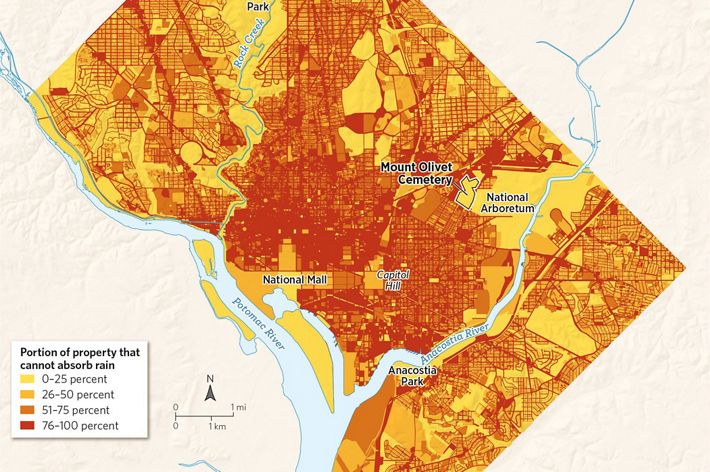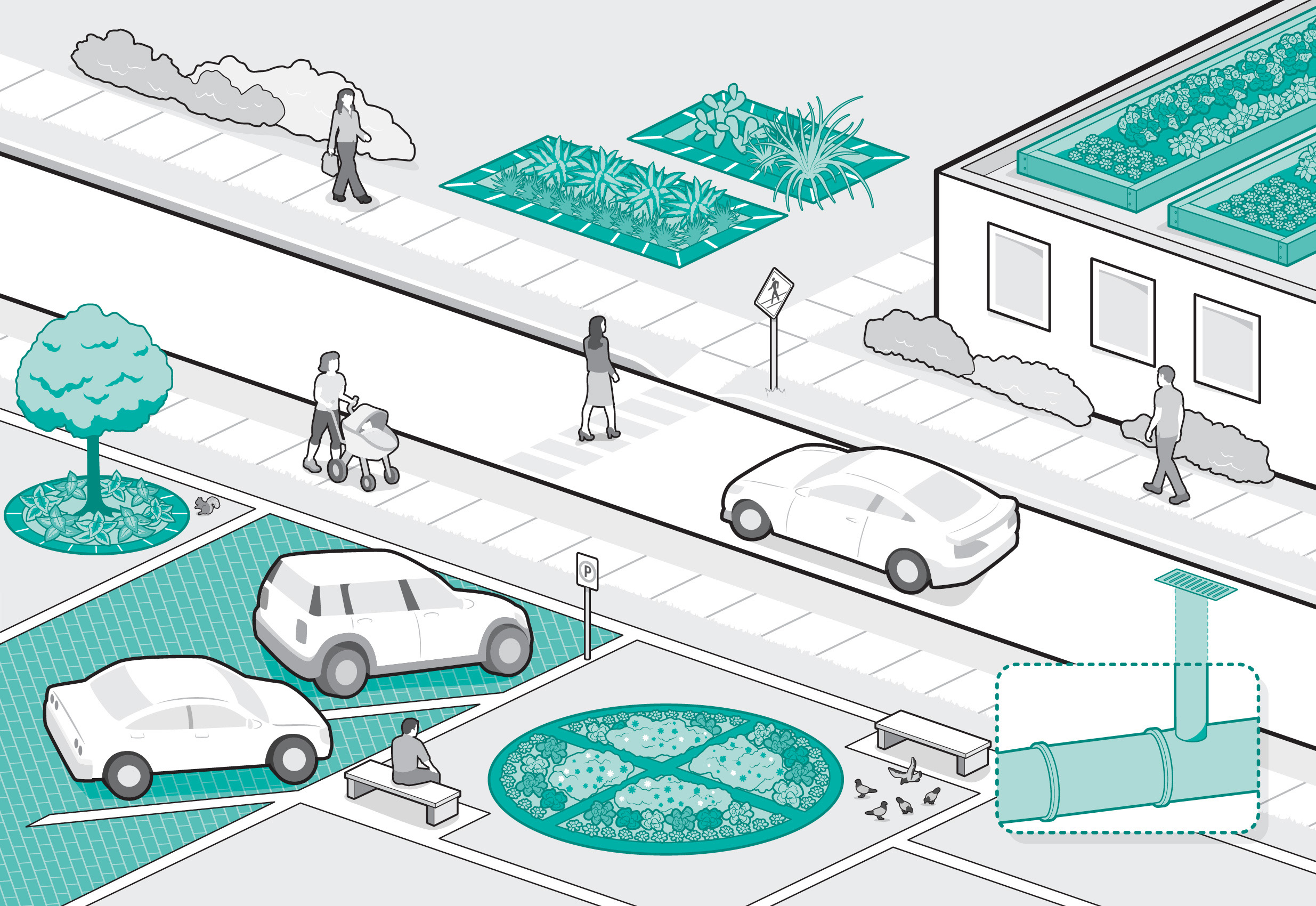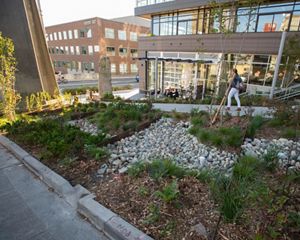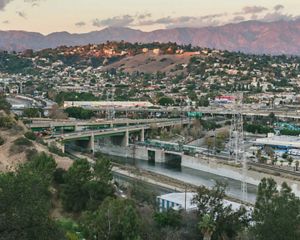Planning for a Rainy Day
Washington, D.C., combines regulations with a new credit market to keep polluted stormwater out of its rivers.
Spring 2019
In 2013, Cheryl Tyiska started work as the new manager at the historic Mount Olivet Cemetery in Washington, D.C. One day, she sat down at her desk, opened the monthly water bill and was stunned into silence. The bill was $6,000 for the 88-acre pre-Civil War cemetery, which employed only a skeleton crew and didn’t even water the grass.
“Our actual water usage, the water that we actually flush toilets with or run the sink with or whatever, runs about $100 a month,” she says. “But our water bill and all the associated fees that go with it was about $6,000 a month.”
Tyiska began looking for an answer. It wasn’t a mistake on the water meter or a clerical slip of the decimal point. The answer lay in a utility program, similar to ones popping up in cities nationwide, that charges landowners not only for their water usage but for treatment costs for stormwater and associated pollution that runs off their property. More precisely, the fee is based on the square footage of paved, roofed or otherwise “impervious” surface on the property. And that 88-acre cemetery had a lot of roads and pathways—almost 10 acres in fact.
After the stormwater fee program went into effect in 2009, all landowners started getting higher water bills from the local utility, DC Water. The fees help pay for a major project to clean the water running into nearby rivers. That’s because water picks up pollutants when it runs across streets, gutters and sidewalks. And each time a storm hits, water runs off hard surfaces and into the sewers, overwhelming the system or running untreated into rivers.
Rain that falls on Mount Olivet and the city’s east side flows to the Anacostia River and eventually ends up in the Chesapeake Bay—the country’s largest estuary, home to bottlenose dolphins, eastern oysters and blue crabs. As more land is developed upstream of the bay, there’s less soft ground for rainwater to seep into, causing runoff—a problem the Environmental Protection Agency (EPA) is requiring cities to address.
When Mount Olivet’s water bill later climbed to $10,000 a month, Tyiska called DC Water. “I said to them, ‘We might have to close our doors because we can’t afford $120,000 a year.’” But even if the cemetery closed, the Catholic Archdiocese of Washington, which owns the land, would still have to pay the fees if nothing changed on the property.
Tyiska began looking for a way out. The only solution, she eventually concluded, was to remove as much paved surface as possible.
To help facilitate those kind of retrofits, the city has created a stormwater credit trading market to encourage landowners to reshape their properties so that the buildings and grounds retain and absorb more water. Stormwater fees aren’t new, but a market-based approach to changing an entire city landscape is—and municipal governments throughout the United States are watching to see how Washington’s policy shakes out.
Mount Olivet stretches over a hill in the northeastern portion of the capital. Across the street is the U.S. National Arboretum, where bald eagles nest and some of the city’s famous cherry trees bloom each spring.
Opened in 1858, the cemetery is in its final years as an active business, Tyiska says. It holds around 180,000 graves and is nearly full. Only perhaps 220 people are buried here each year.
Still, the cemetery is historic. Buried here are notable figures in American history—for instance, Lincoln assassination conspirator Mary Surrat; architect James Hoban, who designed the White House; and Jan Karski, a Polish World War II resistance fighter who was one of the first spies to deliver eyewitness accounts of Nazi atrocities to the Allies. It was also the city’s first large racially integrated cemetery: Buried here are African-American slaves, their wooden grave markers disintegrated long ago.
From the cemetery’s hilltop, construction cranes loom in the distance. Since the 1960s, federal government buildings, apartments and condos have sprung up where greener spaces once stood. That translates to more concrete and hard surfaces—and more stormwater reaching local rivers.
The city sits at the meeting point of the Potomac and Anacostia rivers, with smaller Rock Creek splitting the city between them. The Anacostia once fed 2,500 acres of tidal wetlands. Today the Anacostia is a slow-moving waterway that in some places resembles a lake. Sediment washed downstream from towns and farm fields began filling the river as early as 1800. Before the federal Clean Water Act, Washington regularly dumped raw sewage into the river—as most cities in America did then. Within sight of the Capitol building steps, the river became so filled with sewage and so prone to mosquitoes and malaria outbreaks that the Army Corps of Engineers began dredging it in the 1890s. Today, only 150 acres of the old wetlands remain.
In the last 30 years, the city and local groups like the Anacostia Watershed Society and Anacostia Riverkeeper have fought to clean up the river and make it swimmable and fishable. In 2010, the city introduced a fee on retail shopping bags, with the money going toward river-related projects. Two years later, river stewards reported the number of plastic bags found in the river had dropped more than 70 percent.
“We’ve mostly cleaned up what’s on top of the river,” says Kahlil Kettering, who directs The Nature Conservancy’s work in the Washington, D.C., metro area. “Now we need to clean up what’s in the river.” Put another way, the Anacostia—like most rivers in America—is now dealing with the long-term impacts of sewage and stormwater runoff.
Between 1940 and 2003, stormwater runoff into the Anacostia increased by 250 percent, according to the U.S. Geological Survey. Much of that can be attributed to an increase in paved surfaces, says Masaya Maeda, a water quality expert for the Anacostia Watershed Society. Washington and the surrounding area simply have less green space to absorb water.
Outside the city, the numbers are starker. In 2017, 18.2 million people lived in the Chesapeake Bay’s watershed, up from 12.7 million in 1980. With these newcomers arrive about 10,000 more acres of paved surface every year; or, as the Chesapeake Bay Foundation puts it, a new Washington, D.C., is built every four years. Today, urban and suburban stormwater runoff is the bay’s fastest-growing source of pollution, carrying nitrogen, trash, bacteria, lead and oil among a slurry of runoff.
The bay has struggled for decades with extreme pollution, degraded oyster reefs and the loss of sea grasses that once helped filter the water. In the 1970s, it was declared one of the first marine dead zones in the United States.
With more stormwater coming into the bay, the responsibility to stem the flow has landed on cities in its watershed. Washington has done that largely through a multibillion-dollar tunnel project, paid for in part by the DC Water stormwater fee. The first phase opened in March 2018. The 7-mile, 100-million-gallon tunnel serves as a holding tank, capturing excess stormwater combined with sewage.
Before the tunnel, when major storms hit and flooded the city’s pipes, sewage and stormwater would overwhelm the treatment plants, sending raw sewage pouring into the city’s rivers. The tunnel project has begun to address that problem. In the tunnel’s first six months, the tank captured 3 billion gallons of water, holding it until treatment plants could process it.
But the tunnel handles only the wastewater from pipes where stormwater and sewage combine. Across two-thirds of the city, stormwater simply runs untreated into rivers. Even with an expansion planned, the tunnel alone won’t be enough. But if the city landscape could regain its ability to absorb rain, less would run into the rivers in the first place.
Ways Cities Are Capturing Stormwater
Cities and landowners are using a variety of techniques to trap stormwater and help it seep into the ground quickly. Some of the most cost-effective methods bring more greenery and nature into cities.
Green Roofs
By integrating gardens or grasses into the roofs of new buildings, most stormwater is stored, captured and evaporated or used before it ever reaches the ground.
Bioretention
Rain gardens are designed to capture and disperse water into soil. Bioretention planters, placed along sidewalks, do the same thing but at a smaller scale.
Permeable Pavement
Parking lots, sidewalks and streets that are paved with interlocking bricks allow stormwater to drain down from the surface and into the ground, rather than routing it to storm drains.
Pocket Parks
Cities are turning unused property of all sizes into small parks. They replace paved areas with green space that can trap rain and provide habitat for native pollinators.
Underground Pipes
This is expensive infrastructure that uses larger underground stormwater pipes to store more stormwater and allow time for water-processing facilities to treat it.
In 2011, Craig Holland, an economist with TNC focused on financing conservation, met in Philadelphia with representatives from the Natural Resources Defense Council and Encourage Capital to work on a radical idea: consider ways to make urban water projects an investment opportunity. Meanwhile, Washington had recently enacted its stormwater fee, and in 2013 it introduced the Stormwater Retention Credit market, setting it apart from other cities.
The new marketplace was the first of its kind in the United States. Similar to carbon trading, the market allowed property owners to earn credits based on the amount of stormwater their land could absorb. The credits (one gallon of stormwater retained equals one credit) were eligible to be sold on a city-supported marketplace. Developers would be required to capture a certain amount of rain that falls on their new properties through methods like rooftop gardens, rain gardens or permeable sidewalks. If developers couldn’t capture the required amount, they could buy credits from other property owners as a supplement to their own efforts.
In 2014, Holland says, the market was unproven, but still a “pretty elegant policy solution” that could entice investors to put up the money for new stormwater-retention projects. Holland and TNC, alongside partner Encourage Capital, believed investors could fund a project and sell the credits at a profit.
After a year of financial analysis, TNC’s conservation investing unit, NatureVest, and Encourage Capital created District Stormwater LLC, a company designed to handle stormwater-retention projects. A year later, their first investor put up $1.7 million to finance a pilot project.
At about the same time, Cheryl Tyiska was sitting in a classroom at a church in Hyattsville, Maryland, learning ways to manage stormwater. The First United Methodist Church had rain gardens designed to filter water and keep the parking lot from flooding. It just so happened that this project was managed by the Anacostia Watershed Society, and TNC had partnered with them to help complete it. In addition to providing technical stormwater guidance to Tyiska, Anacostia Watershed Society introduced her to Kettering, who was looking to start a new stormwater project.
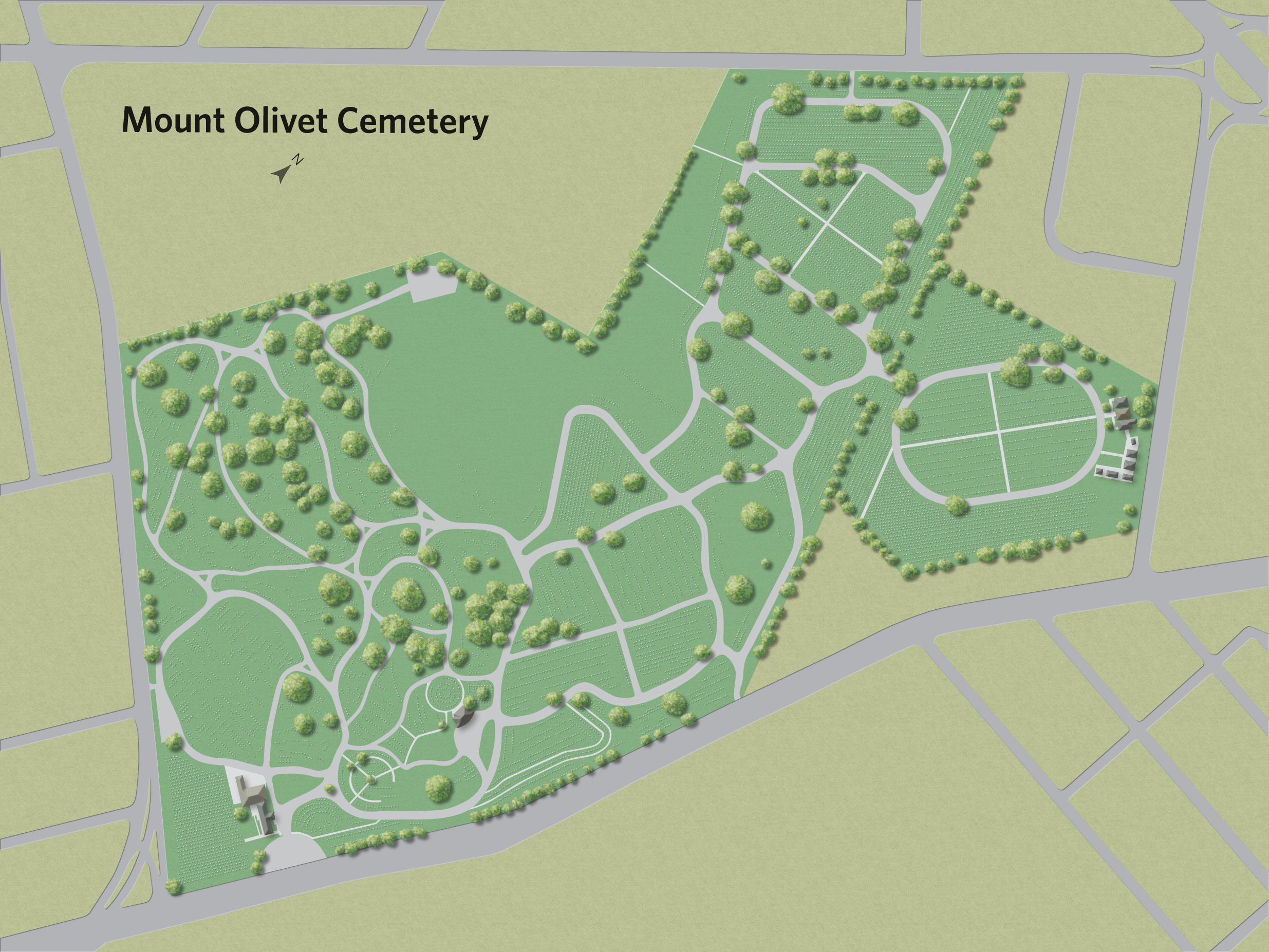
In 2016, District Stormwater partnered with the Archdiocese of Washington, which owns Mount Olivet Cemetery. The next year, the contractor broke ground at the cemetery, careful to avoid any graves. The team tore out 18,000 square feet of paved roads, replacing them with rain gardens and native plants—at no cost to the cemetery.
Ultimately the project generated 276,000 stormwater credits for the first three years, the sale of which is enough to begin repaying the initial investment. Every three years, District Stormwater can sell the credits to the D.C. government or to a developer if a higher bidder comes along. The city has agreed to buy the credits for 12 years, making the investment less speculative. The city government has a stake in ensuring that the credit-trading system works: If cities don’t meet EPA regulations, they risk being sued and paying hefty penalties.
In many cases, Holland says, it is cheaper to develop credits compared with what developers often pay for on-site compliance. “This means the market is working,” he adds. “Developers are saving money, communities are getting more green space, we’re achieving conservation results, and the District is meeting its obligations.”
Even on a dry day, the water is evident in Mount Olivet Cemetery. It drains out of pipes on the side of the road. This is all water that has collected in the cemetery’s rain gardens, slowed down by its filtering layers. About 60 percent of the water that collects here is consumed by plants or evaporates. The rest filters through layers of rock and sand and eventually flows into the river cleaner than before. Because the water comes out slowly and at a smaller volume, it won’t cause erosion when it eventually spills into a nearby creek.
Adding the infrastructure cost Mount Olivet Cemetery nothing and lowered its water bill by about $25,000 a year. For the city, it was a major test of the credit system. And for TNC and its partners, it was a trial run of a new way to fund environmental work. If the numbers could work in Washington, they might work elsewhere. (Read more about TNC's work at Mount Olivet Cemetery.)
The project’s second phase broke ground at the cemetery in November. “We’ve got four or five projects in the pipeline throughout the city that we’re already starting to design plans for next year,” Kettering said in October. Meanwhile, Holland is working with Cook County (home of Chicago) on its own policy structure. Philadelphia, Seattle and Los Angeles have all expressed interest in stormwater credit markets, too.
Downstream, the Anacostia Watershed Society leads groups on canoeing trips along the Anacostia River. Funded by the city bag tax, the trips are meant to reintroduce a city to this river. The canoeists row among lily pads and open water as ospreys fly overhead, while a few plastic water bottles float by. The bottles are now the most common piece of trash found floating on the river’s surface.
In 2018, the University of Maryland released its annual Chesapeake Bay report card. 2017 was “the first year that the overall Chesapeake Bay is showing significant improvement,” it reported. The bay is far from healthy, and water quality dipped during record rains last year. But eight years into a multibillion-dollar, multistate effort to clean up the bay, the university reports suggest that something is finally working.
And at the cemetery, Tyiska gladly makes the case for the work done there to anyone who stops by—it’s more than just a financial solution. For her, a Catholic, there’s a sacredness to the water that flows here. “It’s good for the whole world,” she says. “It’s good for our common home. It’s good for everybody.”
Get the Magazine
Sign up to become a member of The Nature Conservancy and you'll receive the quarterly print edition of the magazine as part of your membership.
